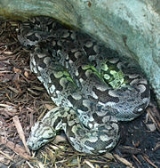
Dumeril's Boa
Encyclopedia
- Common names: Dumeril's boa.
Boa dumerili is a non-venomous boa
Boinae
The Boinae are a subfamily of boas found in Central and South America, Africa and Southeast Asia. Five genera comprising 28 species are currently recognized.-Geographic range:...
species
Species
In biology, a species is one of the basic units of biological classification and a taxonomic rank. A species is often defined as a group of organisms capable of interbreeding and producing fertile offspring. While in many cases this definition is adequate, more precise or differing measures are...
found on Madagascar
Madagascar
The Republic of Madagascar is an island country located in the Indian Ocean off the southeastern coast of Africa...
and Reunion Island. No subspecies
Subspecies
Subspecies in biological classification, is either a taxonomic rank subordinate to species, ora taxonomic unit in that rank . A subspecies cannot be recognized in isolation: a species will either be recognized as having no subspecies at all or two or more, never just one...
are currently recognized.
Description

The color pattern consists of a gray-brown ground color with darker patches, forming an effective camouflage
Camouflage
Camouflage is a method of concealment that allows an otherwise visible animal, military vehicle, or other object to remain unnoticed, by blending with its environment. Examples include a leopard's spotted coat, the battledress of a modern soldier and a leaf-mimic butterfly...
against the leaf litter of the forest floor of their native habitat.
Geographic range
Found on MadagascarMadagascar
The Republic of Madagascar is an island country located in the Indian Ocean off the southeastern coast of Africa...
and Reunion Island (Mascarenes). The type locality given is "Amérique mérid. ?" Given as "?" by Jan (1863).
Habitat
Along the western coast and southwestern regions of Madagascar, it is found in a semi-arid habitat that gets fairly low amounts of precipitation.Conservation status
This species is classified as vulnerable (VU) on the IUCN Red List for the following criteria: A1cd (v2.3, 1994). This means that a population reduction of at least 20% has been observed, estimated, inferred or suspected over the last 10 years or three generations, whichever is the longer, based on a decline in area of occupancy, extent of occurrence and/or quality of habitat, and based on actual or potential levels of exploitation. Year assessed: 1996.Also listed as CITES Appendix I, which means that it is threatened with extinction and CITES prohibits international trade except when the purpose of the import is not commercial, for example for scientific research.
Threatened by deforestation and human persecution. In some areas it is feared and often killed on sight.
Feeding
Their dietDiet (nutrition)
In nutrition, diet is the sum of food consumed by a person or other organism. Dietary habits are the habitual decisions an individual or culture makes when choosing what foods to eat. With the word diet, it is often implied the use of specific intake of nutrition for health or weight-management...
consists of small animals, such as birds, lizards, and small mammals. They are also known to prey on other snakes.
Reproduction
Sexual maturity is within 3 to 5 years of age. Males have anal spurs, which are used in courtship.Their mating season is March through May and the young are born some 6 to 8 months later. Ovoviviparous
Ovoviviparity
Ovoviviparity, ovovivipary, or ovivipary, is a mode of reproduction in animals in which embryos develop inside eggs that are retained within the mother's body until they are ready to hatch...
, females give birth to a litters of 6-28. Neonates are 12-18 inches (30-46 cm) long.
Captivity
Once exported from MadagascarMadagascar
The Republic of Madagascar is an island country located in the Indian Ocean off the southeastern coast of Africa...
in great numbers, trade in this species has since been heavily restricted. They are, however, quite prolific in captivity, and captive bred
Captive breeding
Captive breedingis the process of breeding animals in human controlled environments with restricted settings, such as wildlife reserves, zoos and other conservation facilities; sometimes the process is construed to include release of individual organisms to the wild, when there is sufficient...
animals are relatively inexpensive and easy to find in the exotic pet trade. Though their size makes them more suited to someone experienced with large constrictors, they have a typically docile nature, and readily feed on rats. The main concern is that they are prone to stress, which can sometimes cause them to stop eating or contribute to other health issues.

